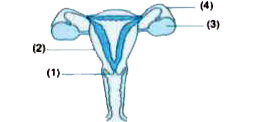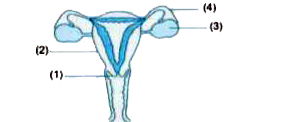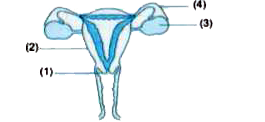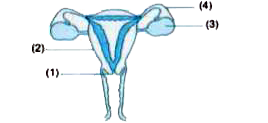The two oviducts in a human female unite into an elastic bag like is know as :
Vagina
Uterus
Fallopian tube
Cervix
Step-by-Step Solution:
1. Understanding the Female Reproductive System: The female reproductive system consists of various structures including the ovaries, oviducts (also known as fallopian tubes), uterus, and vagina.
2. Identifying the Oviducts: The two oviducts are tubes that transport eggs from the ovaries to the uterus. They play a crucial role in fertilization as well.
3. Connecting Oviducts to the Uterus: The oviducts do not function independently; they converge into a single structure that serves as a receptacle for a fertilized egg.
4. Defining the Uterus: The uterus is the elastic, bag-like structure where a fertilized egg can implant and develop into a fetus. It is designed to accommodate the growing baby during pregnancy.
5. Conclusion: Therefore, the two oviducts in a human female unite into the uterus, which is the correct answer to the question.
Final Answer: The two oviducts in a human female unite into an elastic bag-like structure known as the uterus.
---
Topper's Solved these Questions
- BOOK - MBD -HARYANA BOARDCHAPTER - MODEL TEST PAPER -1EXERCISE - SET-C (SECTION - C ( LIFE SCIENCE ))11videos
MODEL TEST PAPER -1
- BOOK - MBD -HARYANA BOARDCHAPTER - MODEL TEST PAPER -1EXERCISE - SET-D (SECTION - C ( LIFE SCIENCE ))10videos
MODEL TEST PAPER -1
- BOOK - MBD -HARYANA BOARDCHAPTER - MODEL TEST PAPER -1EXERCISE - SET-B (SECTION - B ( CHEMISTRY ))5videos
MODEL TEST PAPER -1
- BOOK - MBD -HARYANA BOARDCHAPTER - MBD MOST EXPECTED MODEL TEST PAPER EXERCISE - SECTION-B9videos
MBD MOST EXPECTED MODEL TEST PAPER
- BOOK - MBD -HARYANA BOARDCHAPTER - NEW STYLE MODEL TEST PAPER - 2EXERCISE - SET - D(SECTION -C ( LIFE SCIENCE ))11videos
NEW STYLE MODEL TEST PAPER - 2
Similar Questions
Clitoris in a human female is
View SolutionAnswer question on the basis of your understanding of the following paragraph and the related studied concepts :
(i) When a girl is born, the ovaries already contain thousands of immature eggs
(ii) On reaching puberty, some of these start maturing. One egg is produced every month by one of the ovaries.
(iii) The egg is carried from the ovary to the womb through a thin oviduct or fallopian tube.
(iv) The two oviducts unite into an elastic bag-like structure known as the uterus.
(v) The uterus opens into the vagina through the cervix.

Give suitable terms for starting and ending of reproductive phase in human females.View Solution
Knowledge Check
- Question 1 - Select One
Human females have
A2 pairs of allosomesB46 autosomesC23 pairs of autosomesD44 autosomes - Question 2 - Select One
In human female the blastocyst
AForms placenta even before implantationBHuman male produces one type of gametesCGets implanted in the endometrium by trophoblast cellsDThe trophoblast cells get differentiated as the embryo - Question 3 - Select One
In human female the blastocyst:
AForms placenta even before implantationBGets implanted into uferus 3 days after ovulationCGets nutrition from uterine endometrial secretion only after implantationDGets implanted in endometrium by the trophoblast cells
Answer question on the basis of your understanding of the following paragraph and the related studied concepts :
(i) When a girl is born, the ovaries already contain thousands of immature eggs
(ii) On reaching puberty, some of these start maturing. One egg is produced every month by one of the ovaries.
(iii) The egg is carried from the ovary to the womb through a thin oviduct or fallopian tube.
(iv) The two oviducts unite into an elastic bag-like structure known as the uterus.
(v) The uterus opens into the vagina through the cervix.

What is the site of fertilisation ?View SolutionAnswer question on the basis of your understanding of the following paragraph and the related studied concepts :
(i) When a girl is born, the ovaries already contain thousands of immature eggs
(ii) On reaching puberty, some of these start maturing. One egg is produced every month by one of the ovaries.
(iii) The egg is carried from the ovary to the womb through a thin oviduct or fallopian tube.
(iv) The two oviducts unite into an elastic bag-like structure known as the uterus.
(v) The uterus opens into the vagina through the cervix.

Based on the diagram (1 - 4) and statements [(in) - (v)] given above match the information.View SolutionAnswer question on the basis of your understanding of the following paragraph and the related studied concepts :
(i) When a girl is born, the ovaries already contain thousands of immature eggs
(ii) On reaching puberty, some of these start maturing. One egg is produced every month by one of the ovaries.
(iii) The egg is carried from the ovary to the womb through a thin oviduct or fallopian tube.
(iv) The two oviducts unite into an elastic bag-like structure known as the uterus.
(v) The uterus opens into the vagina through the cervix.

How many eggs are produced each month and why ?View SolutionOogenesis in a human female starts
View SolutionIn human female the blastocyst
View Solution

